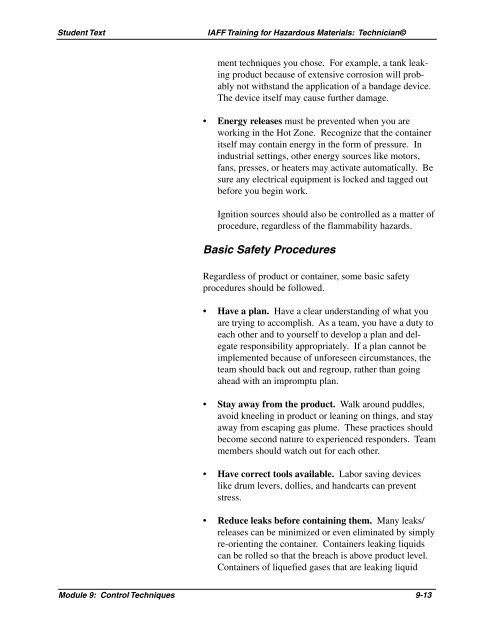Module 9: Control Techniques - International Association of Fire ...
Module 9: Control Techniques - International Association of Fire ...
Module 9: Control Techniques - International Association of Fire ...
Create successful ePaper yourself
Turn your PDF publications into a flip-book with our unique Google optimized e-Paper software.
Student Text IAFF Training for Hazardous Materials: Technician©<br />
ment techniques you chose. For example, a tank leaking<br />
product because <strong>of</strong> extensive corrosion will probably<br />
not withstand the application <strong>of</strong> a bandage device.<br />
The device itself may cause further damage.<br />
• Energy releases must be prevented when you are<br />
working in the Hot Zone. Recognize that the container<br />
itself may contain energy in the form <strong>of</strong> pressure. In<br />
industrial settings, other energy sources like motors,<br />
fans, presses, or heaters may activate automatically. Be<br />
sure any electrical equipment is locked and tagged out<br />
before you begin work.<br />
Ignition sources should also be controlled as a matter <strong>of</strong><br />
procedure, regardless <strong>of</strong> the flammability hazards.<br />
Basic Safety Procedures<br />
Regardless <strong>of</strong> product or container, some basic safety<br />
procedures should be followed.<br />
• Have a plan. Have a clear understanding <strong>of</strong> what you<br />
are trying to accomplish. As a team, you have a duty to<br />
each other and to yourself to develop a plan and delegate<br />
responsibility appropriately. If a plan cannot be<br />
implemented because <strong>of</strong> unforeseen circumstances, the<br />
team should back out and regroup, rather than going<br />
ahead with an impromptu plan.<br />
• Stay away from the product. Walk around puddles,<br />
avoid kneeling in product or leaning on things, and stay<br />
away from escaping gas plume. These practices should<br />
become second nature to experienced responders. Team<br />
members should watch out for each other.<br />
• Have correct tools available. Labor saving devices<br />
like drum levers, dollies, and handcarts can prevent<br />
stress.<br />
• Reduce leaks before containing them. Many leaks/<br />
releases can be minimized or even eliminated by simply<br />
re-orienting the container. Containers leaking liquids<br />
can be rolled so that the breach is above product level.<br />
Containers <strong>of</strong> liquefied gases that are leaking liquid<br />
<strong>Module</strong> 9: <strong>Control</strong> <strong>Techniques</strong> 9-13
















